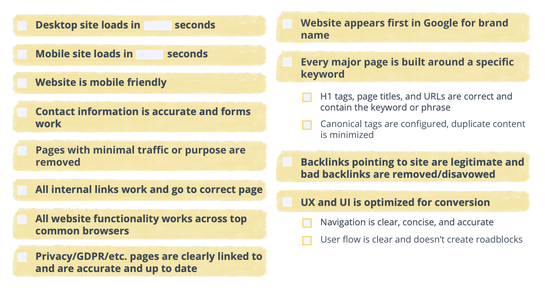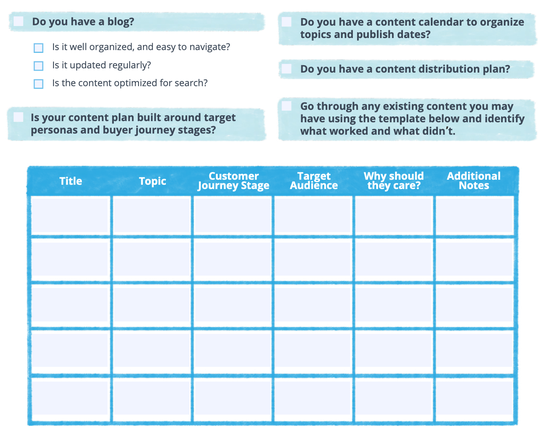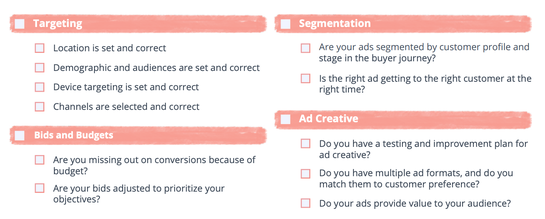To optimize your marketing strategy, you have to look into answering the following questions:
- How is the business performing in terms of profitability and customer perception?
- What are your current marketing strategies? How have they evolved in the past year?
- Where is the business going? Can you reach that point with your current strategies?
Cue the marketing audit. It’s a comprehensive review of your marketing plan, including your business objectives and current activities, to see if there are any areas for improvement. When you conduct a thorough marketing audit, you’ll be able to identify your weaknesses and strengths, so that you’ll know where to place your resources appropriately.
If you don’t do this regularly, you may be wasting valuable marketing dollars. Let’s take a more in-depth look at some of the most critical components of a marketing audit — your website, inbound marketing plan, and paid media — and start the auditing journey.
Website Audit
As an owned channel, your website is one of the few pieces of digital content that you can say is truly under your control. That means it needs to be on point and operating as well as it can at all times. Let's take a minute to do a thorough website audit to make sure that everything is ready to go and to identify areas for improvement.
Click the image below to download this worksheet.![]() This audit will not only give you a good idea of how sound your website’s technical infrastructure is, but it’ll also determine how friendly your website is to search engines. Using the checklist above, you can improve your SEO opportunities by making sure you have the proper H1 tags, page titles, URL links, and more.
This audit will not only give you a good idea of how sound your website’s technical infrastructure is, but it’ll also determine how friendly your website is to search engines. Using the checklist above, you can improve your SEO opportunities by making sure you have the proper H1 tags, page titles, URL links, and more.
To check whether the UX and UI are optimized for conversions, marketers should consider these tips:
- Make sure to keep the interface simple and that the language used in your messages is clear and easy to follow.
- Are the UI elements across your website consistent? Create patterns in design and layout to make it easier for users to navigate.
- Consider the placement of items on your webpage — structure the page so that it draws attention to the most vital pieces of information.
- Strategically use typography, color, and texture. Be mindful of your font type and size for legibility and scanability. By playing around with colors and contrast, you can make certain elements pop.
Suggested reading:
Increase Website Traffic: How to Do It Without Breaking the Bank
Optimize Your Website for Voice Search
How to Build an SEO Strategy for a Direct-To-Consumer (D2C) Brand [TEMPLATE]
Inbound Marketing Audit
How do you get people to your website? Paid media is one option, but real optimization has to be centered around an inbound plan. After all, your goal is to put the customer front and center, and that means giving the customer value even if they don’t immediately buy.
Click the image below to download this worksheet.![]()
The above checklist places a heavy emphasis on content as a central marketing activity. It’s essential to sift through your blogging efforts to figure out whether you need to upgrade the call to actions (CTAs) and if your posts are still relevant. If they are, repurpose and repackage your evergreen content to re-use in other campaigns. Every company should place an emphasis on a consistent blogging strategy in order to maintain traffic.
Suggested reading:
How to Optimize a Blog for SEO [CHECKLIST]
Customer Journey Stages: A Breakdown for Agencies [AUDIO GUIDE]
Subscribe Now: Top Content Marketing Blogs
How to Build a Customer Journey Map [TEMPLATE]
Ready, Set, Call to Action!: Creating a Compelling CTA
Paid Media Marketing Audit
Paid media covers a lot of ground — from search to display to native to social to people on street corners spinning arrows. Let’s think about how your paid media reflects your brand values and helps customers find your products and overcome obstacles. Your marketing audit should consider where your audience is, and what they’re looking for. Are you meeting them where you are, or just shouting from a rooftop?
Click the image below to download this worksheet.![]()
Suggested reading:
How to Find Your Target Audience
How to Create a Behavioral Targeting Strategy
Falling in Love With Customer Segmentation
The Sorting Hat of Marketing: Psychographic Segmentation
Building a Marketing Budget [TEMPLATE + WORKSHEET]
Mobile App Retargeting Best Practices
Keep Yourself Accountable
It’s easy to get lost in the daily grind when running your small business and lose sight of the overall marketing strategy. However, it’s vital never to lose sight of the big picture. By performing a detailed marketing audit, you’ll be able to make sure that your daily activities reflect your business goals.
Are you interested in learning more about how to carve a place for your brand? Check out our interactive workbook, The Ultimate Guide to Building a Digital Brand, to understand how to differentiate your brand from the competition.
Last updated on July 15th, 2024.



